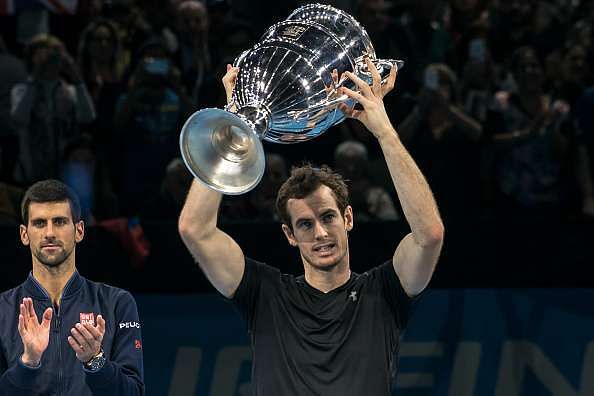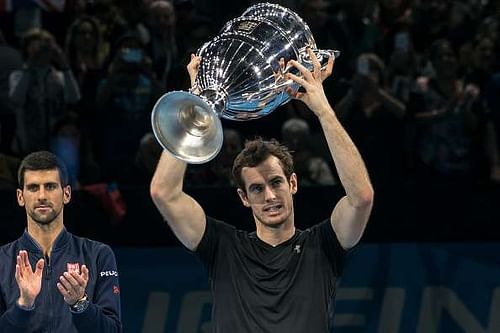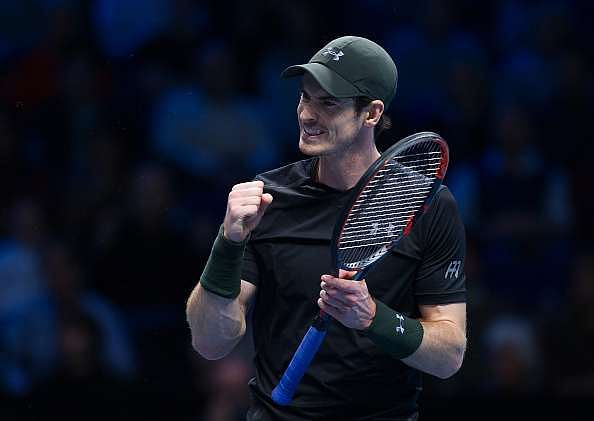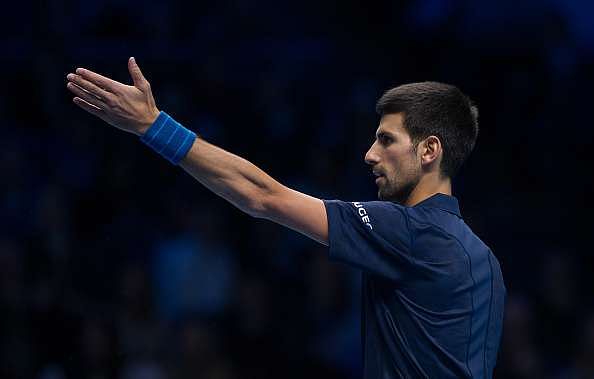
The Murray-Djokovic role reversal: 2016's final battle showed us how one match can change everything

It's easy to assume that Andy Murray's remarkable resurgence in 2016 is down to two things: his improved second serve, and his improved forehand. Most of the manifest evidence backs that up too; the Scot’s average second serve speed this year has been higher than it has ever been in his career, and his forehand has won him a bunch of free points like never before.
But is that all it takes to supplant a GOAT candidate from the top spot? Is it enough to improve two shots and then expect to displace a borderline supernatural being from the throne, to overcome a lead of over 8,000 points in a matter of six months?
We've seen a lot of strange and wonderful things in this golden era of men's tennis – the spectacular tennis, the unmissable drama, the mind-numbing dominance. Maybe it was time for us to see the coinciding of a meteoric rise and a head-scratching downward spiral in the short span of half a season.
What makes up a meteoric rise like Murray's? It doesn't just happen with a snap of two fingers (read shots). Murray's forehand has certainly improved, but it still doesn't take a lot for it to come undone. And since this is Murray we're talking about, ‘coming undone’ doesn't necessarily mean producing a rash of unforced errors. With his historically defensive game and traditionally negative mindset, rolling the ball safely crosscourt is what counts as a shot ‘breaking down’ for him.
Against Milos Raonic in the semifinal, Murray's forehand was both low-pace and error-prone – a terrible combination if ever there was one. In the first set and a half, the racquet head speed on his groundstrokes looked astonishingly low; he didn't seem to have any conviction in his shots. And on the rare occasions when he did go for the kill, he made a hash of it more often than not – especially with his less favoured inside-out version.
The second serve too can still revert to type when he's put under pressure. As Djokovic threatened to mount one of his patented comebacks late in the second set yesterday, Murray's hopes seemed to hinge entirely on his first serve. The second delivery was just being pushed into the box without much sting or purpose – a stark contrast from the first set, where he seemed to be aiming for the line every time.
If Murray's improved second serve and forehand were the only reasons for his rise to the top, he would've probably lost the second set yesterday, and would have most definitely lost the semifinal against Raonic. But what the numbers – and even the shots – don't show, is how much growth the Scot has shown between the ears.
He still descends into expletive-laden monologues when things aren't going his way, but he no longer lets the negativity linger. The hangdog look makes only occasional appearances these days. The fist-pumps are louder and fiercer than before. And most importantly, the offensive play is there for him whenever he needs it, almost like a reluctant but dutiful servant.
Down match point in the third set tiebreaker against Raonic, Murray played the perfect attacking point. He ran the Canadian ragged with a couple of crisply struck forehands, and finished the point at the net with the easiest of volleys.
Yesterday, Murray found himself at 30-30 while serving for the match, with memories of his failed attempts to serve it out against Raonic still fresh in everyone's mind. He sprang to the net again, this time off an approach that wasn't even that good, and against a passer infinitely better than Raonic. But Djokovic missed the lob, and the Scot had his first match point.
He needed another three match points to get the job done, but that point at 30-30 may have been critical in dousing Djokovic's comeback hopes. Murray had laid bare his intent to go on the attack, and the Serb would subsequently be forced to go for more on his shots to prevent his opponent from blasting his way to glory.
Murray has always been a good volleyer – I'd even go as far as saying that he's the best volleyer in the top 10 after Federer. But in the past he's never come to the net often enough, and never been wise about choosing the right points to approach. Now, in 2016, he's still not too keen on approaching the net regularly, but he's learned to pick the perfect moments to do so. Everything he does now seems to have a well-thought-out logic behind it, even if that logic may not be to every shot-making-hungry fan's liking.
How much of this purposeful mindset is down to Ivan Lendl's coaching? Murray had become more forceful with his tennis even during Lendl's first stint, which had yielded both of his previous Majors (in fact, Murray is yet to win a Slam without Lendl in his corner – that's a discussion for another day). But I don't think I’ve ever seen Murray look as assured, as secure, on the court, as he's looked in the second half of 2016. What's that saying again about parenthood and patience?
The Scot doesn't go for broke with his groundstrokes early in a match now, the way he did in that heartbreaking 2012 Wimbledon final, because that's just not his game. Instead, he uses the best tools at his disposal – anticipation, foot speed, touch – to keep his opponents at bay, while bringing out the big guns only at the most important junctures. It sounds like a dangerous strategy in theory, but when you have a clear head and the unmistakable talent to execute your plans, there's no reason why it shouldn't work in practice.
With a calm demeanour possibly born out of the birth of his first child, Murray has been executing his plans like nobody's business in 2016. But it still wouldn't have been enough to get the No. 1 ranking if it hadn't been for...Djokovic's sudden and alarming downslide.
From a man without a weakness to a man without a purpose?
Using words like ‘alarming’ and ‘downslide’ might sound like hyperbole, but it's hard to reconcile the fact that the player we saw yesterday is the same one that ruled tennis with an unbreakable iron fist until June of this year. It's been nearly six months since Djokovic's era-defining French Open win, and the effects of that accomplishment are still reverberating in the tennis world.
Remarkably though, those effects are the exact reverse of what you'd normally expect from a watershed moment. In June, Djokovic was the king of the world, with seemingly no one to stop his inevitable march to GOAT-hood. He was at the top of his game, with all his challengers having fallen by the wayside, and a Calendar Golden Slam looked all but guaranteed.
Murray, meanwhile, looked like a broken man, having suffered possibly the worst meltdown of his career just days after erstwhile coach Amelie Mauresmo practically called him a sourpuss.
Catharsis can be found in the lowest of lows, as Murray showed with his subsequent surge. But can the highest of highs prompt an implosion for the ages?
After chasing a dream for so long, you're bound to experience a let-down when you get there. Djokovic's French Open win ensured that he had something in his CV (four consecutive Slams) that neither Federer nor Nadal has; for all intents and purposes, he had nothing left to achieve after that. ‘Void’, ‘burnout’ and 'fatigue’ were some of the words thrown about to describe his play immediately after Paris, and his coach Marian Vajda hasn't been shy about going down that same route.
But that hasn't made any of his recent struggles easy to digest. The truly unsettling thing is that Djokovic hasn't just been playing like his pre-2011 days; he's been playing worse than he ever has. Before 2011, his biggest crimes were being too passive in rallies and not flattening out his forehand when he had the chance to end a point. But even back then, his consistency was unparalleled; you'd almost never find him making regulation errors.
Yesterday, however, the man was nearly unrecognizable. He overhit his backhand on many of the big points, made a few club-grade volley errors, and pulled his forehand wide without reason. He looked so out of sorts that our memories of his usually superhuman play almost vanished; one of the commentators even said that Djokovic has never been as good a mover as Murray (which is a sacrilegious thing to say, in my opinion).
The game with him serving at 1-3 in the second set made for one of the strangest sights of the year. Djokovic seemed to have mentally checked out by that point; he swung his racquet wildly, without a care in the world, and missed the lines by miles. I almost had to rub my eyes in disbelief as I struggled to comprehend the reality of it all.
This was not the Djokovic that opponents everywhere have come to respect and fear. This was not a player concerned about his destiny. This was not...normal.
It's a mark of how brilliant the Serb has been over the last few years that it’s his sub-par play, rather than his machine-like efficiency (which was on sharp display just a day earlier, in his match against Kei Nishikori), that catches your attention. But that's the price you pay for uncharted excellence; as Roger Federer said back in 2008, you create a ‘monster'.
There have been several signs in the last few months that grinding out wins day-in and day-out is not Djokovic's top priotiy any more. The most notable of those signs, of course, was that he said as much. But since that gasp-inducing comment, the 12-time Slam champion has gone about doing everything in his power to restore some semblance of peace in his tennis life. He has even sought help from...a guru specializing in ‘long hugs'.
Whichever way you look at it, things aren't very rosy for the Serb at the moment. But we saw just six months ago how a low point can be a catalyst for great things. Who's to say Djokovic doesn't return a man recharged next season, and ready to resume his reign over the tennis world again?
The 2017 Australian Open promises to be a firecracker of a tournament for many reasons, not least of which is the possibility that Federer and Nadal could meet each other in the third round. But I for one will be looking more intently at Djokovic, and whether he resembles the all-conquering marauder from early 2016, or the all-collapsing moocher from late 2016.
It might well be just one match that turns him from one version to the other. And it wouldn't be surprising if it's that man Murray again who is at the other side of the net when the transformation occurs.

